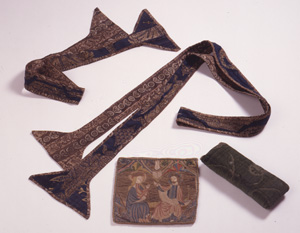|
|
You are here:
Ecclesiastical vestments
(12/13)
The Cistercians initially prohibited
ornate, ecclesiastical vestments. All clothing and decoration was
to be simple. For example, the chasuble,
which was worn by the celebrant at Mass, was to be made of wool
or linen, free from silk or gilt weave; stoles and maniples were
to be of silk,
without any gold or silver embroidery.
Later on more elaborate
decoration was introduced, and by the later Middle Ages Cistercian
liturgical vestments
could be highly ornate.
The following images are of ecclesiastic
vestments thought to have belonged to the monks of Dore Abbey,
Herefordshire, and
which are now in the Victoria and Albert Museum, London.(11)
Burse
The burse was used as a case to carry the corporal (the cloth on
which the consecrated elements are placed during Mass). This finely-embroidered
linen burse, which dates from the late fourteenth or early fifteenth
century (c. 1370-1430), was made in England; both sides show the
coronation of the Virgin, with Christ blessing her.
Chasuble
This sleeveless garment was worn by the celebrant at Mass, and
although it was made in Italy may have belonged to Dore
Abbey in
Herefordshire, in the fifteenth century. It is dark-blue figured
velvet woven on an orange background, and forms part of a set with
the maniple and stole (see below). The design incorporates leafy
and flowering stems, and a pomegranate pattern, a motif associated
with the Virgin. The orphreys were embroidered in England, not
Italy. These are finely crafted in silk and gold, and show the
figures of Christ on the Cross (centre), St John the Evangelist
with a cup, and St Thomas the Apostle with Moses.
Maniple
The maniple, a narrow strip of cloth worn draped over the celebrant’s
left arm, was used originally to wipe tears shed for the peoples’ sins.
The above maniple forms part of a set with the chasuble (above)
and stole (below), is of Italian design and dates from c. 1470
X 1530. It is brocade, woven in blue and gilt thread, lined with
printed linen and over three feet long.
Stole
This ecclesiastical vestment, worn by priests, deacons and bishops,
dates from c. 1470 X 1530, and is of Italian design. It forms
part of the matching set with the chasuble and maniple (above). It is
brocade, woven in blue silk and gilt thread, lined with printed
linen and over eight feet long.
<back><next>
|







